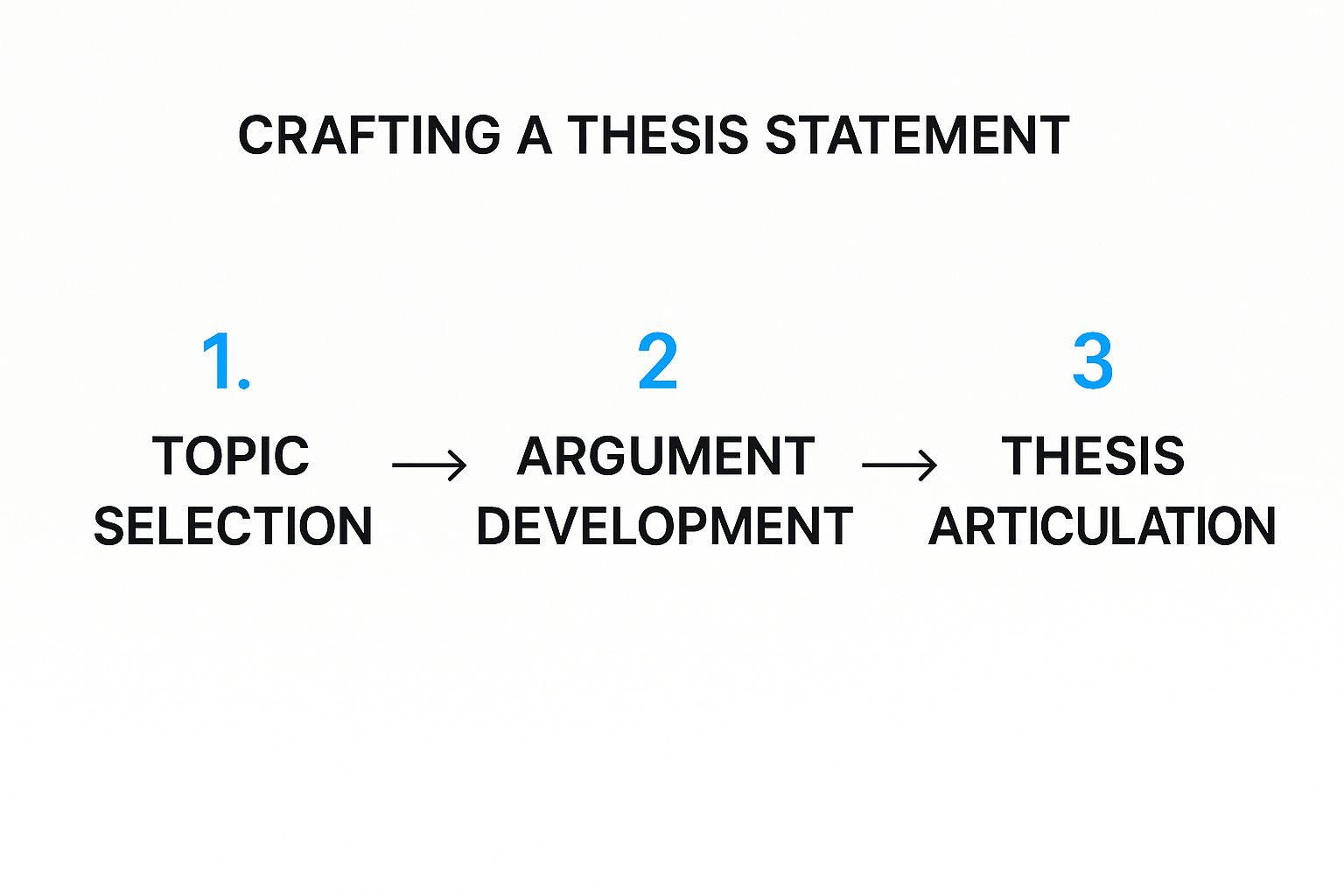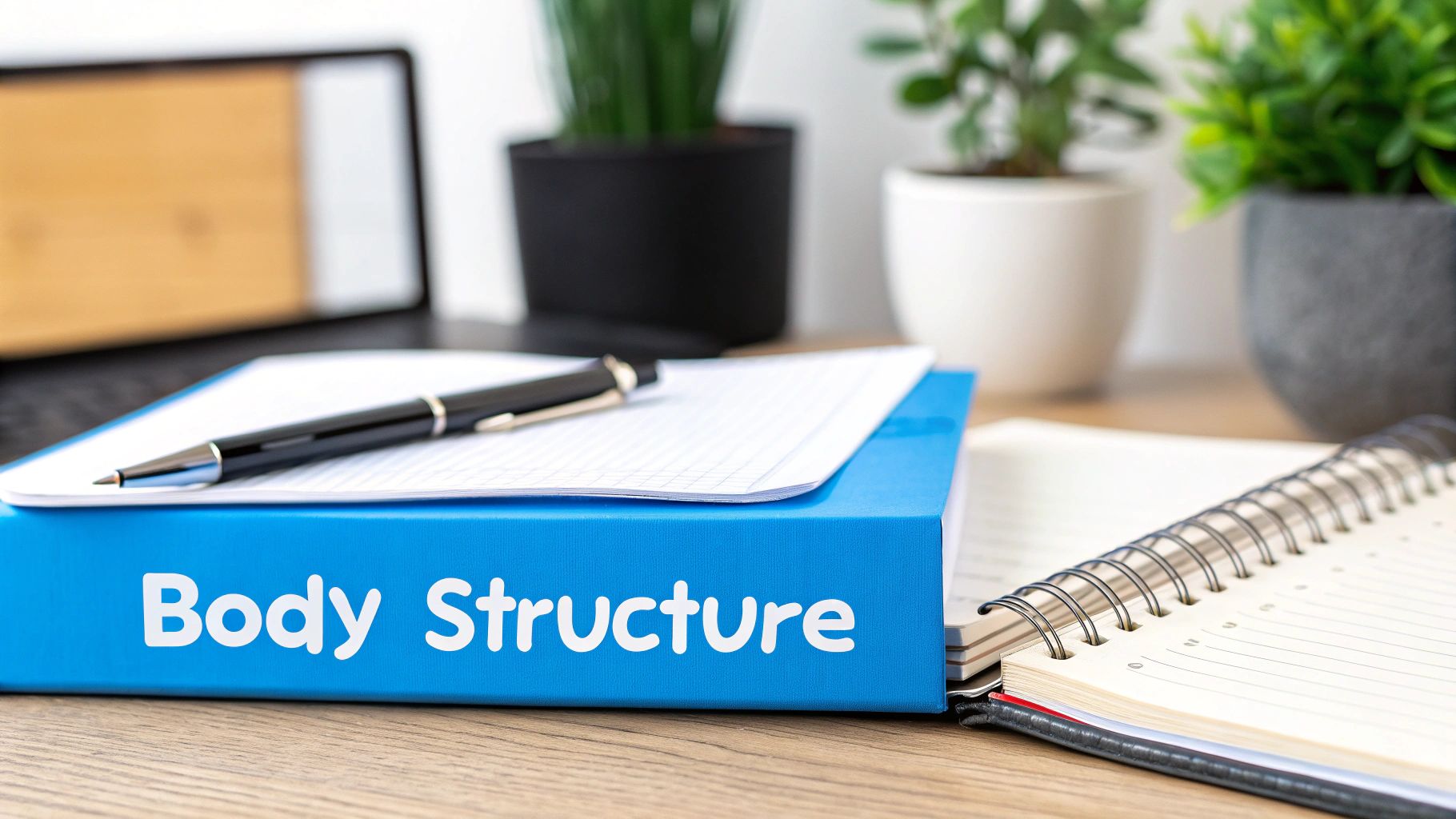Academic Essay Template That Actually Gets Results

Why Most Academic Essays Fall Short (And Yours Won't)
Let's be real—we’ve all slogged through essays that were technically fine but completely forgettable. After grading countless papers and listening to faculty discussions, I've noticed a clear pattern. The leap from a B+ to an A+ paper rarely comes down to perfect grammar or the number of sources cited. It’s about a common, but critical, misunderstanding of what professors are actually looking for.
Most essays miss the mark because they just present information. Truly exceptional essays, however, construct a powerful argument that actively steers the reader’s thinking.
The Psychology of a Memorable Essay
An impressive essay does more than just tick the boxes on the assignment sheet; it sparks an intellectual conversation with your professor. The trick is to stop thinking in terms of a simple list of facts and start building a narrative. Picture your argument not as a collection of points but as a journey you're leading your reader on. Your objective is to make your conclusion feel both insightful and unavoidable. This is all accomplished with a strong, clear structure that guides the logical flow.
For instance, many standout papers use what’s called the hourglass model. This structure begins with a broad context in the introduction, zooms in on a very specific thesis, and then broadens out again in the conclusion to touch on the bigger picture. This approach doesn't just keep your thoughts organized; it gives your argument a sense of purpose and weight. To see this in action, you can look into the structural guides that top universities like Harvard recommend to their students.
From Competent to Compelling
So, how do you make that jump from simply competent to genuinely compelling? The key is to view your academic essay template as a flexible blueprint for persuasion, not a rigid box you have to fill. Here’s the fundamental difference:
- Weak Essays: State a topic and then list supporting evidence. The argument often feels choppy, like a series of unrelated observations.
- Strong Essays: Start with a clear, debatable claim and use evidence to build a unified case, one paragraph at a time.
This strategic mindset is what takes your work to the next level. It’s not only about what you say, but how you construct your argument. It’s also important to remember the human element; even the best template is only as good as the thinking behind it. With many students now curious about the role of AI, you can explore whether AI can write effective essays in our detailed article. This foundational approach will change how you write, making sure your essays leave a real impression.
The Complete Academic Essay Template Framework
Instead of a rigid, one-size-fits-all format that makes your writing sound stiff, think of this framework as a flexible blueprint for almost any academic essay. It’s a system designed to give you structure while letting your unique voice and arguments shine through.
A great essay flows like a good story—it has a clear beginning, a detailed middle, and a strong finish. Studies on successful academic papers show a common pattern: about 10-15% of the word count goes to the introduction, 70-80% to the body paragraphs, and the final 10-15% to the conclusion. This isn't a hard rule, but it's a solid guideline. For a 2,000-word essay, that means your intro and conclusion would each be about 200-300 words, leaving you with a hefty 1,400-1,600 words to build your core arguments.
To help you visualize how to allocate your effort and word count, here's a breakdown of what each section should accomplish.
| Section | Word Count (%) | Primary Focus | Key Elements |
|---|---|---|---|
| Introduction | 10-15% | Engage the reader and state the main argument. | Hook, background context, thesis statement. |
| Body Paragraphs | 70-80% | Present and analyze evidence to support the thesis. | Topic sentences, evidence (quotes, data), analysis, linking sentences. |
| Conclusion | 10-15% | Synthesize arguments and highlight the overall significance. | Restated thesis, summary of key points, "so what?" factor. |
This table shows that the bulk of your work lies in developing the body paragraphs, where you'll prove the claims you made in your introduction.
Core Components of the Framework
The real strength of this template is how its parts work together. Each section has a specific job, guiding your reader logically from your initial claim to your final conclusion.
-
The Introduction (The Hook and Thesis): Your first job is to grab your reader’s attention with a compelling hook. From there, you set the stage before presenting your thesis statement—arguably the most important sentence in your entire essay. It's your promise to the reader, clearly stating what you intend to prove.
-
The Body Paragraphs (The Evidence): This is where you make good on that promise. Each paragraph should tackle one specific idea that supports your thesis. A fantastic tool for structuring these paragraphs is the PEEL method:
- Point: Start with a clear topic sentence.
- Evidence: Back it up with a quote, data, or source material.
- Explanation: Analyze the evidence and explain how it supports your point.
- Link: Connect your point back to the main thesis or transition to the next paragraph.
-
The Conclusion (The "So What?"): A strong conclusion does more than just summarize. It should pull all your main points together, restate your thesis with fresh wording, and answer the critical "so what?" question. Why does your argument matter in the bigger picture? What are the implications of your findings?
From Topic to Thesis
A powerful thesis statement doesn't just appear fully formed—it’s the final product of careful thinking. This visual shows how you can narrow a broad topic into a focused, arguable claim.
As the infographic shows, refining a broad subject into a sharp, defensible thesis is a step-by-step process. This focused claim will become the backbone of your entire essay, guiding every paragraph you write.
Writing Introductions That Professors Remember
Your introduction is your first and only chance to show your professor that the next few pages are worth a deep read. We're always told to start with a hook, but a random statistic or a broad question usually falls flat in an academic paper. A great introduction does something more interesting: it establishes an intellectual puzzle or a compelling problem that your essay will solve. Instead of just announcing your topic, frame it as a conversation that needs to happen.
Let's say you're writing about the Industrial Revolution. A generic start would be, "The Industrial Revolution was a period of great change." A much stronger approach would be to highlight a paradox: "While the Industrial Revolution is celebrated for its technological leaps, it simultaneously created urban poverty on an unprecedented scale. How could a period of such progress produce such deep social fractures?" This immediately shows you're thinking critically.
From Hook to Thesis
Once you've set up this puzzle, the rest of your introduction should act as a bridge, guiding the reader from that initial problem straight to your thesis statement. This is where you connect the dots for them.
- Provide essential context: Give your reader just enough background to understand the problem you've presented. Think of it as setting the stage. Be brief and to the point.
- Transition to your claim: Use phrases like, "This tension reveals…" or "A closer look suggests that…" to smoothly lead into your argument.
- State your thesis clearly: Your thesis should be the direct, concise answer to the puzzle you posed in your opening.
This structure does more than just check boxes. It builds anticipation, making your thesis feel like a necessary and insightful conclusion, not just a required sentence. This approach transforms your academic essay template from a simple outline into a powerful framework for intellectual engagement, inviting your professor into a discussion they actually want to be a part of.
Crafting Body Paragraphs That Build Unstoppable Arguments
If your introduction makes a promise to the reader, your body paragraphs are where you cash that check. This is the moment your academic essay template stops being a simple outline and starts becoming a compelling argument. The idea isn't just to list facts; it's to weave them into a story so convincing that your reader arrives at your conclusion feeling it's the only logical outcome.
A truly persuasive paragraph does more than just state a point. It guides your reader's thinking, making every piece of evidence feel like a deliberate, well-placed move. Think of it less like a grocery list and more like a masterful courtroom argument where every piece fits together perfectly.
The Anatomy of a Powerful Paragraph
The strongest body paragraphs follow a predictable rhythm that builds momentum. I've seen countless students elevate their writing simply by mastering these key components:
- A Clear Topic Sentence: This is your paragraph's mini-thesis. It must be a specific, arguable claim that directly supports your essay's main argument. For example, instead of a vague statement like "The Industrial Revolution had social effects," aim for something precise: "The mechanization of labor during the Industrial Revolution directly eroded the autonomy of skilled artisans."
- Seamless Evidence Integration: Just dropping a quote into your paragraph without any setup can be jarring for the reader. You need to introduce your evidence by explaining who said it and why their perspective is important. For instance, starting with "As historian E.P. Thompson notes…" lends immediate credibility to your source before the reader even sees the quote.
- Deep Analysis (The "So What?"): This is where the magic happens and where you connect the dots. After presenting your evidence, explain how it proves your topic sentence. What are the implications? Why is this piece of information significant? This analysis is what separates a simple summary from a genuine, persuasive argument.
- A Strong Concluding Link: Your final sentence should do one of two things: either summarize the paragraph's main point or create a smooth bridge to the next idea. This ensures your essay flows logically from one point to the next, without any abrupt stops.
This structure guarantees that each paragraph acts as a self-contained argument that builds toward your overall case. While this framework is a solid starting point, don't forget the final polish. Once your arguments are structured, you might want to learn more about whether an AI can proofread your essay to catch small errors that could weaken your credibility. It's a quick final check that can make a huge impact.
Adapting Your Template For Different Academic Challenges
A great academic essay template isn't a strict set of rules but more of a flexible framework. While the core structure—introduction, body, and conclusion—is a constant, how you use it will change with each assignment. For instance, a literature review means your body paragraphs will weave together themes from many sources. A case study, however, requires you to focus intensely on one specific example. The trick is to know which parts of your template to expand and which to condense for the best results.
Think about a comparative essay. Your body paragraphs would likely each tackle a single point of comparison, discussing both subjects side-by-side. An argumentative essay is different; you'll need to set aside paragraphs to address and debunk counterarguments, something you probably wouldn't do in a personal reflection paper.
Navigating Discipline-Specific Nuances
The field you're studying also changes how you'll use a template. A philosophy paper, for example, is all about the logical flow of your argument, so the clarity of your reasoning is everything. In contrast, a psychology report places a huge emphasis on the methodology and results sections, which might even take up more space than the introduction and discussion.
The assignment's own rules are another big deal. Some programs have very strict formatting to keep assessments fair. The International Baccalaureate (IB) Extended Essay, for instance, has a firm 4,000-word limit. Examiners are told not to read past that point, which means going over the limit hurts your score before they've even started grading. You can find more details about this in their official guidelines.
This ability to adapt is key to doing well. For students with learning differences like dyslexia, using assistive technology for dyslexia) can make a huge difference in applying these template variations successfully. It’s also important to maintain academic integrity when bringing in new ideas, whether from your own research or from AI tools. Our guide on how to use AI without plagiarizing can help with that. This flexible mindset ensures you're always picking the right approach for each unique assignment.
Template Pitfalls That Sabotage Good Essays
An academic essay template can feel like a helpful guide, but relying on it too strictly can turn a promising essay into a stiff, robotic piece of writing. One of the most common issues is when a student follows the formula so closely that their own voice and critical thoughts disappear. The final essay looks like a paint-by-numbers project—all the pieces are in place, but it lacks personality and insight. The idea is to use the template as a starting point, not a cage for your ideas.
Another major problem is confusing structure with substance. Simply having an introduction, a few body paragraphs, and a conclusion doesn't guarantee a compelling argument. Each part of your essay needs to logically connect to the next, guiding your reader through your thought process. For example, a body paragraph might have a topic sentence and supporting evidence, but if you don't analyze how that evidence proves your main thesis, it's just a random fact floating on the page.
Avoiding the Formulaic Trap
So, how do you steer clear of these traps? First off, think of your template as a suggestion, not a set of commands. After writing your first draft, go back and challenge every formulaic phrase. Instead of a generic transition like "In conclusion," ask yourself, "What's the real takeaway here?" This simple mental shift pushes you to synthesize your points rather than just re-listing them.
The pressure to deliver perfect essays has created a huge market for writing help. The global essay writing service industry hit a value of around $1.97 billion in 2023 and is projected to more than double by 2032. You can read more about this trend in this detailed industry report. This number shows just how many students are looking for an easier way out, but authentic, personal writing will always make a better impression.
To help you spot and fix these common issues, I've put together a table that breaks down the mistakes I see most often when students use templates.
| Common Error | Why It Happens | Quick Fix | Prevention Strategy |
|---|---|---|---|
| Over-relying on the template | Fear of getting the structure wrong or a lack of confidence in one's own writing. | Reread your draft aloud. Does it sound like you or a robot? Rewrite sections that feel stiff. | Use the template for your outline, but then put it away while you write the first draft to let your own voice emerge. |
| Generic, placeholder language | Using stock phrases like "In conclusion" or "This essay will discuss" because they feel safe. | Replace generic phrases with more dynamic, specific statements. For instance, turn "In conclusion" into "Ultimately, the evidence suggests…" | Create a "banned words" list for yourself of common template phrases and challenge yourself to find alternatives. |
| Weak analysis | Focusing on filling the paragraph structure (topic sentence, evidence, etc.) but forgetting to explain the why. | For every piece of evidence, add a sentence that starts with "This shows that…" or "This is important because…" | After each body paragraph, write a one-sentence summary of its main point. If you can't, you need more analysis. |
| Losing your authorial voice | The essay becomes a collection of facts and quotes without a clear perspective guiding the reader. | Insert your own "I think" or "I argue" statements (then remove the "I think" part) to make your claims more direct. | Pretend you're explaining your argument to a friend. How would you phrase it? Use that conversational energy in your writing. |
This table should help you diagnose problems in your drafts. The key takeaway is that templates are tools, not replacements for your own critical thinking.
Before you submit your work, running it through a good AI essay checker can catch spots where your writing sounds too mechanical. This gives you a chance to go back and infuse more of your personality into the text.
If you're ready to write essays that truly reflect your own unique perspective, Word Spinner can help. It assists in refining your arguments, humanizing your text, and making sure your voice is loud and clear in every assignment. Start your free trial today and feel the difference.



